After watching the Yankees lose on Thursday night, I had a very familiar reaction watching Aaron Judge’s at-bats.
In the Yankees first game against the Orioles, Judge fell behind 0-2 in both his first and his last at-bat. For Judge, it seems like this happens often; I sometimes find myself pleading to him to swing at some pitches that land in the middle of the zone early in the count.
Although I know he is at his most dangerous when he isn’t chasing pitches out of the zone, Judge is supposed to be one of the main run-producers of the lineup and thus he should look to do damage on very hittable pitches instead of waiting for the perfect pitch. Judge himself admits he’s hunting for these mistakes:
"“My plan is always looking for a fastball down the middle.”"
I think that is every hitter’s plan at the plate, but when you’re Aaron Judge, how many times should you expect to see a fastball down the middle? The answer is not very often. Another Judge quote after his struggles in their opening series against the Blue Jays:
"“The biggest thing is I’ve got to stay patient and hunt those mistakes. If I get away from my approach, it doesn’t turn out too well.”"
Judge is right and is no doubt at his best when he’s patient, but when you’re as big and as strong as Judge is, you shouldn’t look solely for mistakes and put yourself at risk of falling into a huge hole down 0-2 or 1-2. This just leaves him more susceptible to the strikeouts his massive frame already leaves him prone to.
In fact, pitchers are trying to exploit this about Judge, which Blake Snell of the Rays admitted after the Yankees trio of Judge, Giancarlo Stanton, and Gary Sanchez all homered off him:
"“Those guys, they are great hitters, but you need to get ahead of them. You can’t afford to go 2-and-0 to guys that can now sit dead red on a certain pitch and do the damage that they’re paid to do.”"
He’s right, and the stats back him up. Check out Judge’s batting average on various pitch counts compared to the MLB average:
Aaron Judge's batting average by pitch count. Article on this coming soon. pic.twitter.com/HHMaCxLiYG
— Mike Mastroianni, MD (@MikeMastroMD) April 6, 2018
As you can see by this chart, Judge is generally much better than the MLB average when he doesn’t have two strikes, but when he does he is similar to the average hitter. Therefore, there is a much steeper drop-off for Judge whenever he accumulates two strikes.
More from Yankees News
- Aaron Judge’s influence on Carlos Rodón shows he’s more powerful than Yankees
- Yankees sign 2022 Red Sox reliever, invite him to spring training
- Yankees trade Lucas Luetge for 2 intriguing Braves prospects after DFA
- Never forget Miguel Andújar wrecked Yankees’ Nolan Arenado trade
- Diamondbacks outfielder’s comment on Carlos Rodón’s IG raises eyebrows
When looking at the number of at-bats where he accumulated two strikes in 2017, my hunch seems correct. Last year, Judge had 419 plate appearances with two strikes, including 50 when down 0-2, 94 when down 1-2, 103 when down 2-2, and 172 when the count was 3-2.
Compare this to Joey Votto, a power hitter who also works counts and led the league in OBP last year: Votto had 316 plate appearances with two strikes, including 37 when down 0-2, 66 when down 1-2, 83 when down 2-2, and 130 when the count was 3-2. Although he’s very patient, Votto seems to have a quicker trigger than Judge and doesn’t back himself into a corner with two-strikes, which could be one reason he only struck out 83 times in 2017 compared to Judge’s 208.
Next: This is the year of Didi
Listen, Judge is already a fantastic hitter with a great approach but that doesn’t mean he can’t improve upon it. While he should keep his patient approach, he could do even more damage by swinging at pitches in the heart of the zone.
